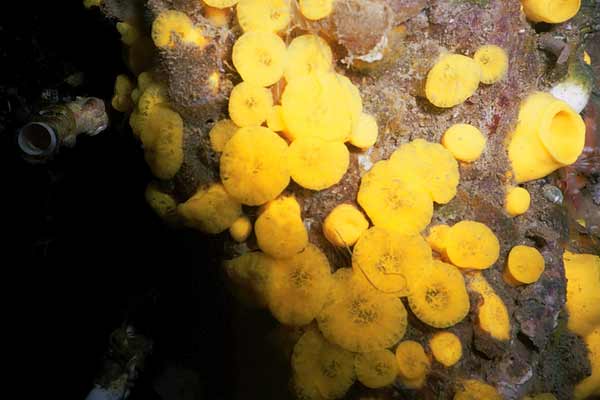
| Porifera | ||
| Porifera | tetractinomorpha |
| Metazoa | Metazoa | Metazoa | ||||
| Time |
|
Porifera
├─Archaeocyatha
└─┬─Stromatoporoidea
└─┬─Calcarea
└─┬─Hexactinellida
└─┬─Demospongiae
│ ├─Tetractinomorpha
│ └─Ceractinomorpha
└─┬─Homoscleromorpha
└─Eumetazoa
|

These are encrusting massive or branching sponges, which range from intertidal habitats to abyssal depths of at least 5500 meters. While the 6 orders comprising this subclass share common features it is probable that the assemblage is polyphyletic. [ref: Curt Smecher]
The current party line on Tetractinomorpha is that they are likely to be polyphyletic. That is, most of the main groups making up the Tetractinomorpha seem to be good clades, but few sponge workers are still willing to bet that all of these clades are more closely related to each other than to any of the ceractinomorphs. While it is entirely possible that some stripped-down group of tetractinomorph sponges is monophyletic, the current refusal to commit to any particular phylogenetic scheme is, based on our present state of ignorance, undoubtedly wise as well as prudent.
Traditionally, distinction between Tetractinomorpha and Ceractinomorpha was often based largely "on an oviparous versus viviparous strategy of reproduction, [a distinction which] has been rejected by all molecular phylogenies produced so far." Boury-Esnalt & Solé-Cava (2004) (see, e.g., Schmitt, 2002). However, oviparity is not completely useless for phylogenetic purposes. Since all Calcarea and Hexactinellida are viviparous, as are Homoscleromorpha. Thus any oviparous sponge is almost certainly a demosponge, even if we draw no other conclusion.
The free-living larvae of tetractinomorphs are parenchymella or "creeping blastula" larvae. The latter is a form which slowly rolls along the bottom, using successive rows of cilia to pull itself across the substrate. Tetractinomorphs have both large (megasclere) and small (microsclere) spicules. The megascleres are frequently a mixed population of tetraxons (4 axes) and monaxons (1 axis). Tetractinomorph microscleres include star-shaped (asterose) spicules. This microsclere morphology, like oviparity, is only found among traditional tetractinomorphs. However neither oviparity nor star-shaped microscleres are universal in this group. One early report states that tetractinomorph collagen may differ in several respects from collagen in other demosponges. Diehl-Siefert et al. (1985). However, this needs to be confirmed with more details and a broader sample of taxa. Blumenberg's 2003) useful and thought-provoking survey of sponge (except Calcarea) lipid chemistry notes that tetractinomorphs show considerably less variation than ceractinomorphs in the structure of their sterols, and usually synthesize an 18C Δ5.9 unsaturated fatty acid which is almost unique to the taxon.
The sponges included in the Tetractinomorpha vary a bit from author to author, but generally include the Astrophorida (or Choristida), Hadromerida, and Spirophorida, as well as some or all lithistid sponges. ATW071227
Curt Smecher, Tetractinomorpha Levi - distinguishing characteristics in note form.
Parker, Sybil P. (ed.), 1982: Synopsis and Classification of Living Organisms. New York: McGraw-Hill Book Co., 2 vols.
